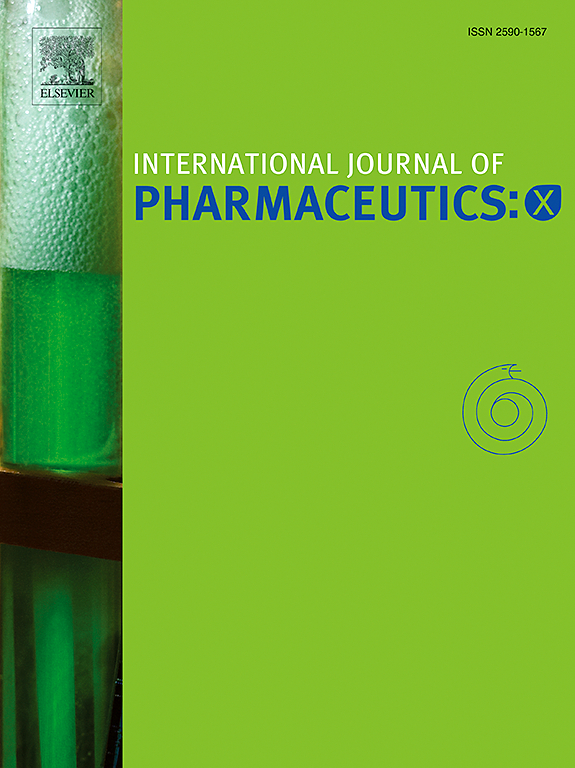An iterative process and mixture design approach for dry granulated ternary blends of filler-binders
IF 6.4
2区 医学
Q1 PHARMACOLOGY & PHARMACY
引用次数: 0
Abstract
Roller compaction/dry granulation (RC/DG) is a key process in pharmaceutical manufacturing for improving powder flowability, density, and segregation resistance. Advanced statistical modeling was used to optimize RC/DG process parameters and subsequently binder compositions by employing process and mixture design experiments. The authors used microcrystalline cellulose (MCC), silicified MCC (SMCC), and dicalcium phosphate (DCP) as filler-binder examples in RC/DG experiments. Granule and tablet properties, including flowability, bulk and tapped densities, as well as resistance to crushing, were analyzed using compendial methods. The process design experiments confirmed that RC/DG reduces manufacturability compared to direct compression. Optimal processing conditions, balancing sufficient tablet strengths and granule formation, were identified to be between 20 (SCF * ϑ) [kN/cm] and ∼ 60 (SCF * ϑ) [kN/cm]. Thereby (ϑ) is defined as the screw-to-roll speed ratio and (SFC) as the specific compaction force. Mixture design experiments revealed optimal mixtures balancing SMCC, MCC, and DCP to achieve desired properties like low angle of repose, high bulk density, and strong tablets. These findings provide guidance for selecting formulations and process parameters in RC/DG applications. The derived ‘SCF * ϑ’- factor was found to effectively describe the granulation intensity. A superimposed mixture design model based on precise target values of the parameters bulk density, flow properties, and breaking force allowed identification of the best formulation.

填料-粘结剂干燥颗粒状三元共混物的迭代过程及混合物设计方法
辊子压实/干燥造粒(RC/DG)是制药生产中改善粉末流动性、密度和抗分离性的关键工艺。采用先进的统计模型,通过工艺和混合物设计实验,优化RC/DG工艺参数和粘合剂组成。以微晶纤维素(MCC)、硅化MCC (SMCC)和磷酸二钙(DCP)为例进行了RC/DG实验。使用药典方法分析了颗粒和片剂的性能,包括流动性、体积和密度以及抗破碎性。工艺设计实验证实,与直接压缩相比,RC/DG降低了可制造性。最佳工艺条件是平衡足够的片剂强度和颗粒形成,在20 (SCF * φ) [kN/cm]和~ 60 (SCF * φ) [kN/cm]之间。因此,定义(φ)为螺杆-辊速比,(SFC)为比压实力。配合比设计实验揭示了SMCC、MCC和DCP的最佳配合比,以获得低休止角、高堆积密度和强片剂等理想性能。这些发现为RC/DG应用中选择配方和工艺参数提供了指导。推导出的' SCF * * ' -因子被发现能有效地描述造粒强度。基于体积密度、流动特性和破碎力等参数的精确目标值,建立了叠加混合设计模型,从而确定了最佳配方。
本文章由计算机程序翻译,如有差异,请以英文原文为准。
求助全文
约1分钟内获得全文
求助全文
来源期刊

International Journal of Pharmaceutics: X
Pharmacology, Toxicology and Pharmaceutics-Pharmaceutical Science
CiteScore
6.60
自引率
0.00%
发文量
32
审稿时长
24 days
期刊介绍:
International Journal of Pharmaceutics: X offers authors with high-quality research who want to publish in a gold open access journal the opportunity to make their work immediately, permanently, and freely accessible.
International Journal of Pharmaceutics: X authors will pay an article publishing charge (APC), have a choice of license options, and retain copyright. Please check the APC here. The journal is indexed in SCOPUS, PUBMED, PMC and DOAJ.
The International Journal of Pharmaceutics is the second most cited journal in the "Pharmacy & Pharmacology" category out of 358 journals, being the true home for pharmaceutical scientists concerned with the physical, chemical and biological properties of devices and delivery systems for drugs, vaccines and biologicals, including their design, manufacture and evaluation. This includes evaluation of the properties of drugs, excipients such as surfactants and polymers and novel materials. The journal has special sections on pharmaceutical nanotechnology and personalized medicines, and publishes research papers, reviews, commentaries and letters to the editor as well as special issues.
 求助内容:
求助内容: 应助结果提醒方式:
应助结果提醒方式:


